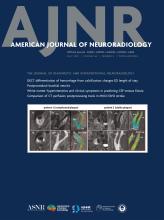This article requires a subscription to view the full text. If you have a subscription you may use the login form below to view the article. Access to this article can also be purchased.
Abstract
BACKGROUND AND PURPOSE: Acute ischemic strokes caused by distal medium vessel occlusions (DMVOs) represent a remarkable proportion of all stroke cases, yet the predictors of excellent functional outcomes in these patients remain poorly understood. This study aims to identify pretreatment CTP parameters associated with excellent functional outcomes, defined as an mRS score of 0–1 at 90 days, in patients with anterior circulation DMVO.
MATERIALS AND METHODS: We conducted a retrospective multicenter study involving patients with anterior DMVO, from 2 stroke centers within the Johns Hopkins Medical Enterprise. Baseline demographic, clinical, and imaging data were collected, with CTP parameters analyzed by using RapidAI software. Univariable and multivariable logistic regression models were used to identify predictors of excellent outcomes. Receiver operating characteristic (ROC) curves were constructed to assess the predictive accuracy of CTP parameters.
RESULTS: Among the 82 patients (median age, 71 years; 57% women), occlusions were located in the M2 segment in 89%, M3 in 8.5%, and A2 in 2.4%. Intravenous thrombolysis (IVT) was administered to 37% of patients, and endovascular therapy (EVT) was attempted in 59%. Excellent outcomes at 90 days were achieved in 45% of patients. In univariate analysis, white race (OR, 4.14; 95% CI, 1.66–10.9; P = .003), higher CBV index (OR per 0.1-unit change, 1.45; 95% CI, 1.08–2.05; P = .022), and lower relative CBF (rCBF <20%) volumes (OR, 0.91; 95% CI, 0.81–0.98; P = .038) were significantly associated with excellent outcomes. In multivariate analysis adjusting for age, sex, race, IVT administration, EVT attempted, dyslipidemia, and premorbid mRS, higher CBV index remained a significant independent predictor (OR per 0.1-unit change, 1.72; 95% CI, 1.14–2.81; P = .017), and lower rCBF <20% volume was associated with better outcomes (OR, 0.91; 95% CI, 0.80–0.98; P = .05). The multivariate model demonstrated good predictive performance (area under the ROC curve, 80%; 95% CI, 70%–90%; P < .001).
CONCLUSIONS: In patients with anterior circulation DMVO, a higher CBV index on pretreatment CTP is an independent predictor of excellent functional outcomes at 90 days. These findings suggest that CTP parameters, particularly the CBV index, may be useful in prognostic assessment for this stroke population. Further studies are needed to validate these results and optimize therapeutic approaches.
ABBREVIATIONS:
- ACA
- anterior cerebral artery
- AUC
- area under the curve
- DMVO
- distal medium vessel occlusion
- EVT
- endovascular therapy
- HIR
- hyperfusion intensity ratio
- IQR
- interquartile range
- IVT
- intravenous thrombolysis
- LVO
- large vessel occlusion
- mTICI
- modified TICI
- ROC
- receiver operating characteristic
- rCBF
- relative Cerebral blood flow (CBF)
- Tmax
- time to maximum
- © 2025 by American Journal of Neuroradiology












